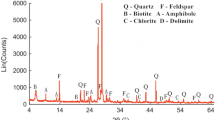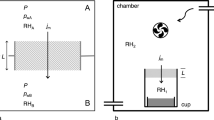Abstract
Moisture damage induced by dynamic pore water pressure commonly occurs in asphalt pavement with a service environment of frequent contact with liquid water. Dynamic water environment exhibits a different mechanism of moisture damage comparing with traditional static water immersion and freeze-thaw. The influencing factors of dynamic water environment mainly include the magnitude of pore water pressure, water temperature, and conditioning duration. This paper presents a study on evaluating and quantifying these factors’ degree of influence on moisture sensitivity of asphalt mixture using the orthogonal test and the gray correlation analysis method. A new method for moisture sensitivity evaluation was thus proposed based on dynamic water environment conditioning and uniaxial penetration strength test. Finally, the influence of materials’ properties on moisture sensitivity were further investigated. The results indicated that the ranking of factors impacting the indicator of fracture work density was water temperature, followed by pore water pressure and conditioning duration. A representative parameter combination of 60℃, 0.345 MPa, and 4000 cycles was thus recommended. It was found that dynamic water environment was harsher than static water immersion and almost equal to and even harsher than freeze-thaw. The indicator of fracture work density ratio, which took deformation feature of asphalt mixture into account, could well assess moisture sensitivity. Retained mechanical performance of water-conditioned asphalt mixture decreased with the increase of air void content. SBS modified asphalt binder significantly improved the resistance to moisture damage for asphalt mixture.
Similar content being viewed by others
References
W. Wang, L. Wang, H. Xiong, R. Luo, A review and perspective for research on moisture damage in asphalt pavement induced by dynamic pore water pressure, Constr Build. Mater. 204 (2019) 631–642.
Research Institute of Highway Ministry of Transport, Standard test methods of bitumen and bitumen mixtures for highway engineering. JTG E20-2011. China Communication Press, Beijing, China, 2011, pp. 197–202.
American Association of State Highway and Transportation Officials, Standard method of test for resistance of compacted asphalt mixtures to moisture-induced damage. AASHTO T283. AASHTO, Washington DC, USA, 2006.
S. Lamothe, D. Perraton, H. D. Benedetto, Contraction and expansion of partially saturated hot mix asphalt samples exposed to freeze-thaw cycles, Road Mater. Pavement Des. 16 (2) (2015) 277–299.
B. Hu, X. Zhang, Reduction of asphalt concrete anti-fatigue performance under hydrodynamic effect, J Harbin Inst. Technol. 48 (3) (2016) 120–124.
Y. Guo, A. Shen, The preventive maintenance of fiber reinforced chip seal. China Communication Press Co., Ltd., Beijing, China, 2018.
A. Lacroix, A. Regimand, L. James, Proposed approach for evaluation of cohesive and adhesive properties of asphalt mixtures for determination of moisture sensitivity, Transp Res. Rec. 2575 (2016) 61–69.
M. B. Bouraima, Y. J. Qiu, Investigation of influential factors on the tensile strength of cold recycled mixture with bitumen emulsion due to moisture conditioning, J Traffic Transp. Eng. 4 (2) (2017) 198–205.
P. R. Kaukuntla, Standard ruggedness study on moisture induced sensitivity tester (MIST). (Bachelor of Science thesis), Osmania University, Hyderabad, India, 2014.
M. Hou, Study in the effect of water-temperature coupling on the performance of asphalt mixture and the prevention and control method, (Doctoral thesis), Harbin Institute of Technology, China, 2015.
American Society for Testing and Materials, Standard practice for moisture conditioning compacted asphalt mixture specimens by using hydrostatic pore pressure. ASTM D7870/D7870M-13. ASTM, West Conshohocken, PA, 2013.
J. Lee, S. J. Moon, J. Im, S. Yang, Evaluation of moisture susceptibility of asphalt mixtures using dynamic modulus, J Test. Eval. 45 (4) (2017) 1280–1288.
M. T. Weldegiorgis, R. A. Tarefder, Towards a mechanistic understanding of moisture damage in asphalt concrete, J Mater. Civ. Eng. 27 (3) (2015) 04014128.
A. Khodaii, V. Khalifeh, M. H. Dehnad, G. H. Hamedi, Evaluating the effect of zycosoil on moisture damage of hot-mix asphalt using the surface energy method, J Mater. Civ. Eng. 26 (2) (2014) 259–266.
R. A. Tarefder, A. M. Zaman, Nanoscale evaluation of moisture damage in polymer modified asphalts, J Mater. Civ. Eng. 22 (7) (2009) 714–725.
K. Liu, L. Deng, J. Zheng, Nanoscale study on water damage for different warm mix asphalt binders, Int J. Pavement Res. Technol. 9 (6) (2016) 405–413.
Ministry of Transportation of the People’s Republic of China, Test method of uniaxial penetration strength for asphalt mixture. JTG D50-2017. Specifications for design of highway asphalt pavement, China Communication Press Co., Ltd., Beijing, China, 2017, pp. 59–62.
L. Sun, Shear strength measurements for asphalt mixture, in: Structural behavior of asphalt pavements, Butterworth-Heinemann, UK, 2016.
Ministry of Transportation of the People’s Republic of China, Technical specifications for construction of highway asphalt pavements. JTG F40-2004. China Communication Press, Beijing, China, 2004, pp. 9–15.
W. Wang, R. Luo, G. Feng, L. Wang, Impact factors in rotational viscosity tests, J Wuhan Univ. Technol.: Transp. Sci. Eng. 40 (3) (2016) 514–518.
H. Wen, Use of fracture work density obtained from indirect tensile testing for the mix design and development of a fatigue model, Int J. Pavement Eng. 14 (6) (2013) 561–568.
M. Barman, R. Ghabchi, D. Singh, M. Zaman, S. Commuri, An alternative analysis of indirect test results for evaluating fatigue characteristics of asphalt mixes, Constr Build. Mater. 166 (2018) 204–213.
J. Ji, H. Yao, W. Zheng, Z. Suo, Y. Shi, Y. Xu, … Z. You, Preparation and properties of asphalt binders modified by THFS extracted from direct coal liquefaction residue, Appl Sci. 7 (11) (2017) 1155.
G. Zou, J. Xu, C. Wu, Evaluation of factors that affect rutting resistance of asphalt mixes by orthogonal experiment design, Int J. Pavement Res. Technol. 10 (3) (2017) 282–288.
P. Tian, A. Shukla, L. Nie, G. Zhan, S Liu, Characteristics’ relation model of asphalt pavement performance based on factor analysis, Int J. Pavement Res. Technol. 11 (1) (2018) 1–12.
Z. Zhao, Grey system theory and its application in automobile engineering. Science Press, Beijing, China, 2018, pp. 20–25.
Michelin America, The latest load and inflation table standards. (Michelin, 2019), https://www.michelintruck.com/reference-materials/manuals-bulletins-and-warranties/load-and-inflation-tables/#/. Accessed 7 April 2020.
Federal Highway Administration, Most traveled highway sections. Average annual daily traffic (AADT) 250,000. (FHWA, 2019), https://www.fhwa.dot.gov/policyinformation/tables/02.pdf. Accessed 7 April 2020.
R. A. Tarefder, M. T. Weldegiorgis, M. Ahmad, Assessment of the effect of pore pressure cycles on moisture sensitivity of hot mix asphalt using MIST conditioning and dynamic modulus, J Test. Eval., 42 (6) (2014) 1530–1540.
Author information
Authors and Affiliations
Corresponding author
Additional information
Peer review under responsibility of Chinese Society of Pavement Engineering.
Rights and permissions
About this article
Cite this article
Wang, W., Wang, L., Yan, G. et al. Evaluation on moisture sensitivity of asphalt mixture induced by dynamic pore water pressure. Int. J. Pavement Res. Technol. 13, 489–496 (2020). https://doi.org/10.1007/s42947-020-0141-x
Received:
Revised:
Accepted:
Published:
Issue Date:
DOI: https://doi.org/10.1007/s42947-020-0141-x




